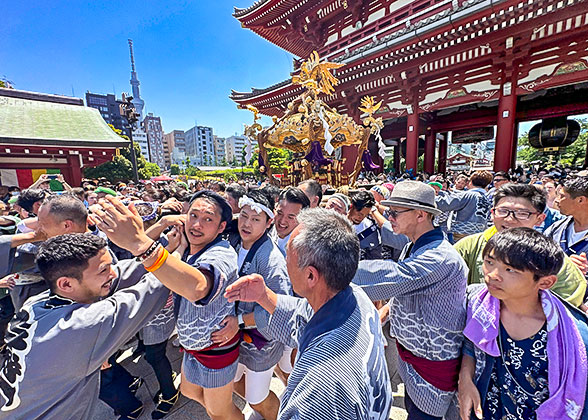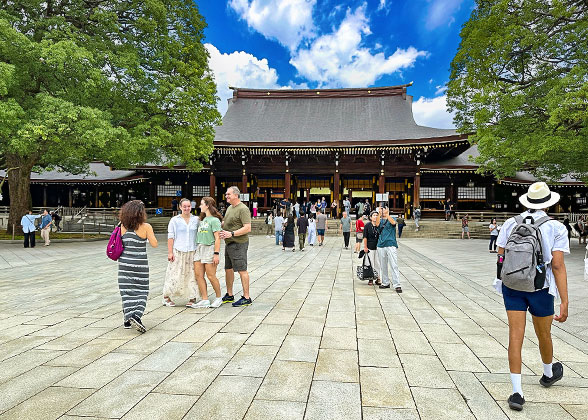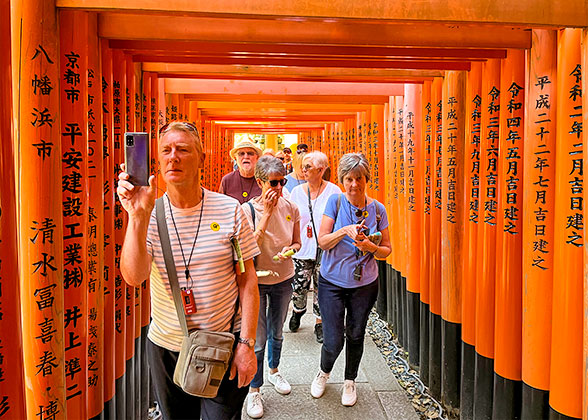Nagoya Weather in January
 In short: cold, dry, short daytime
In short: cold, dry, short daytimeIn Nagoya, January is the coldest month of the year. The average high temperature is only 9℃ (48.2℉), and it drops greatly at night. It is often windy in this month, which brings down the temperature to some extent. Besides, January belongs to the dry season. It seldom rains or snows, leading to a total precipitation of only 48mm (1.9in) on average. In such climate, you do not have to worry about your clothes getting damp when going out. But in January, the sun rises late and sets early, providing limited daytime for visiting. Therefore, if you plan to travel to Nagoya this month, remember to make a good plan in advance to make full use of the daytime.
See also: Japan Weather in January

Tower in Nagoya Castle
|





Clothes Guide in January

|
 Top: Considering the cold weather in January, warm clothes are needed. Lightweight wool sweaters and fleece hoodies with a down coat or padded jacket can ensure free physical activities while keeping warm.
Top: Considering the cold weather in January, warm clothes are needed. Lightweight wool sweaters and fleece hoodies with a down coat or padded jacket can ensure free physical activities while keeping warm.
 Bottom: winter pants, thick sweatpants
Bottom: winter pants, thick sweatpants Shoes: Comfortable and warm sneakers or walking boots are necessities for long-time walking in this month.
Shoes: Comfortable and warm sneakers or walking boots are necessities for long-time walking in this month.
 Other items: If you are the one who is afraid of the coldness, it is advised to prepare a scarf, gloves and a woolly hat.
Other items: If you are the one who is afraid of the coldness, it is advised to prepare a scarf, gloves and a woolly hat.
Top Things to Do in Nagoya in January, 2026
Tourism Rate:


Visiting Nagoya Castle
January belongs to the low tourism season. If you schedule your trip in January 2026, you will not be bothered by crowds of tourists and can leisurely explore the popular destinations. For most visitors visiting Nagoya, especially for those who are interested in history, Nagoya Castle is a must-go.Nagoya Castle is famous for its two golden ornaments shaped like a mythical creature with an animal’s head and a fish’s body. As the symbol of Nagoya, it showcases the history and culture of the city. It is made of wood, with an exquisite structure. Climbing to the top of the Main Keep, you can not only admire the amazing exhibitions inside but also enjoy a panoramic view of the whole city. On Saturdays and Sundays, you can watch performances of ninjas and warriors in Ninomaru Square and take photos with actors for free.
Tip:
For the sake of protecting cultural relics, you need to put on special slippers before entering the Main Keep.

Honmaru Palace in Nagoya Castle
|
Learning about Japanese Shrine Culture in Atsuta Jingu Shrine
Shrines are common in Japan due to the close connection between Shintoism and people’s daily life. If you want to have a fulfilling culture tour in January when there are not many tourists, Atsuta Jingu Shrine is recommended.Atsuta Jingu Shrine, built in the 2nd century, is the second largest shrine in Japan with “Hota Daishin” as the main deity, attracting nearly 7 million visitors every year. It is known for worshiping the Kusanagi no Tsurugi sword, which is one of the Three Sacred Imperial Treasures of Japan. There are multiple attractions such as the Nobunaga Wall and the Atsuta Shrine Museum housing a number of national treasures.
Some sacrificial and festival activities are held in the shrine every year. During the New Year worship period in January, many tourists flock to pray. On January 15, an archery ceremony is held to pray for a good harvest and eliminating diseases and disasters. You will have a wonderful cultural experience when watching the celebration.

Lively Atsuta Jingu Shrine in January
|
Soaking in Hot Springs
Winter is generally considered to be the best time to enjoy hot springs bath, which is a popular relaxing activity in Japan. It can strengthen blood circulation to help dispel the coldness in chilly weather.Nagoya is famous as a hot spring resort in Japan. It boasts many unique hot spring halls where visitors can bath in onsens while enjoying authentic Japanese cuisine. For example, Ryusenji Onsen, located at the Ryusenji Temple, is a natural outdoor hot spring bath. At dusk, you can watch the sunset when soaking in the open-air onsen area. At night when lights are lit up, it turns to be a popular destination for dreamy atmosphere and night view.

Nagoya's Onsen Hotel
|




